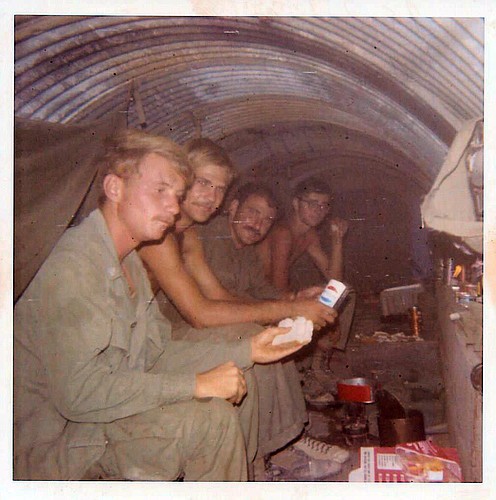- December 13, 2025
-
-
Loading

Loading

It took Lee Tefertiller 45 years before he would wear anything associated with the military or, more specially, the Vietnam War.
“I just left it alone,” Tefertiller, of Ocoee, said. “And now, as I get older, (my service) means more to me now. … It meant a lot to me then, but … I just kind of put it away.”
He also recently joined the local Veterans of Foreign Wars and American Legion organizations, which offer support and advocate for veterans.
It has taken Tefertiller, now 67, nearly five decades to feel comfortable acknowledging with the public his involvement with the Vietnam War. The California native followed his father into the military, joining the United States Army in July 1968; he served nearly three years.
After training at Fort Lewis (now McChord Air Force Base) in Washington and Fort Sill in Oklahoma, Tefertiller arrived in the Hoc Mon district of Vietnam in March 1969 with the 82nd Airborne Division, 2nd Battalion, 321st Artillery.
“Then you get into the nitty-gritty of things,” he said. “Basically what I did was, a forward observer out with the infantry would call back to us at battery with a fire mission. My guys would plot the coordinates that he gave you and from that they would derive the data that's necessary to go to the guns to fire so we're shooting in the right direction.
“I was the chief computer, I was the calculator,” he said.
After a round was fired, the forward observer made adjustments and another shot was made. If it hit the intended target, the observer commanded the artillery to open fire.
“Sometimes you would find them (the Viet Cong) walking in the open,” he said. “We do our best to take them out. … You have to be good at what you do because those are your brothers (you’re protecting).
“People think that we were fighting for our country,” Tefertiller said. “No, we fought for each other.”
Living quarters were tight when he was with the battery; there were several bunking in half culvert pipe stacked up on ammunition boxes with sand bags on top to protect them from incoming mortar shells and rockets.
Fighting in Vietnam was difficult, he said, as one never was quite certain who or where the enemy was.
“Sometimes it could be the farmer who sold you something in the daytime and then was blowing you up in the night,” he said. “The VC didn’t wear a uniform; they wore black pajamas — that’s what we called them. That was typical of the Vietnamese to wear that.”
This allowed them to blend inconspicuously with the public.
The Viet Cong was made up of the “locals,” Tefertiller said, who were the southern Communists and supported the North Vietnamese Army.
The 82nd was sent home in December 1969, but after a few months with the stateside Army, Tefertiller was longing to go back. The following May, he joined the 3rd Battalion, 13th Artillery’s 25th Infantry Division in the Tay Ninh Province and returned to his familiar job of computing the coordinates.
In December, the 25th was sent home, but Tefertiller was sent to another unit, II Field Force, 5th Battalion, 42nd Artillery northeast of Saigon (now Ho Chi Minh City) for more of the same job duties.
“We were out in the boondocks,” he said. “Sometimes you don’t even know where you’re at.”
COMING HOME
“It wasn’t a real pleasant experience,” Tefertiller said of returning home after the war. “When you went to San Francisco airport, there were all kinds of people who did not appreciate what you did. And not knowing who you were and what you did. You got painted with the same broad brush that everybody got painted.”
Protestors greeted the veterans carrying angry signs, screaming at them and spitting on them.
“I couldn't get my uniform off quick enough,” he said. “We had to wear it home; in order to get a military discount, you had to fly in your uniform. … But you did kind of stick out, because of your uniform, your haircut. That's when all the men had long hair. You could be spotted easy.”
Tefertiller, a specialist fifth class, earned several medals, including the Bronze Star with Oak Leaf Cluster, Army Commendation with Oak Leaf Cluster and the National Defense Service Medal, as well as several Republic of Vietnam medals.
He said the military was a good experience and he “wouldn’t trade it for anything,” but it was time to move in a different direction.
Following his wartime experience, Tefertiller worked for the Department of Defense as a civilian employee for about 27 years before retiring. He married a veteran from the Vietnam era, and he has one son — who joined the Army’s 82nd Airborne, too — and one granddaughter.
They moved to Ocoee in 1998 to be closer to his brother, a Windermere resident at that time.
Tefertiller is getting more involved in the two local veteran organizations and also participates with the Patriot Guard Riders, which honors veterans and first responders at funerals and military events.
“And that's all happened in the last six months,” he said. “I guess I was ready. I just wasn't ready before. It's interesting how your perspective changes as you get older.”
A trip to Washington, D.C., might be in his future, as well. He has never seen the Vietnam Veterans Memorial, where the names of more than 58,000 veterans are inscribed, and would like to pay his respects.
Tefertiller was not wounded in the Vietnam War and has suffered no side effects of the chemicals used in the war.
“I thank my lucky stars every day that I’m in such good health,” he said. “Agent Orange was around. I'm just a fortunate guy. … (A lot) had it worse than me.”